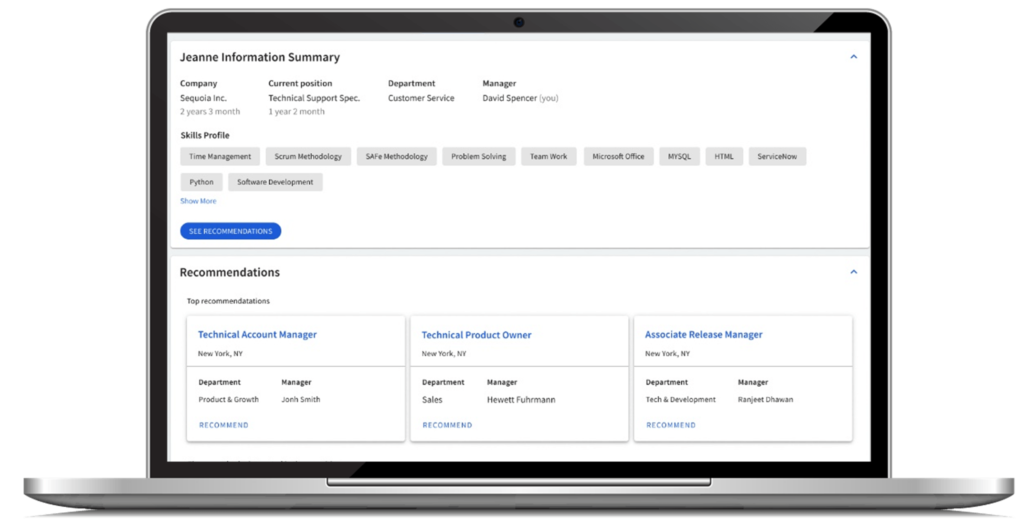Key takeaways:
- Quiet hiring is the process of developing internal staff to fill critical positions or outsourcing job functions to independent contractors.
- This practice helps companies meet current staffing needs and provides employees with opportunities for professional development.
- When engaging in quiet hiring, employers should promote a work-life balance, provide equitable access to advancement opportunities, and compensate employees properly.
Also read: Employee Retention Strategies & Benefits
What is quiet hiring?
Quiet hiring describes the practice of training current employees to cover key roles or outsourcing critical projects to contract workers. To fill in-demand positions, recruiters don’t necessarily need to look far for the talent the company needs, as there’s a good chance it already exists in-house.
In other words, quiet hiring puts succession planning into practice.
Quiet hiring vs. quiet quitting
Quiet hiring is distinct from quiet quitting, which occurs when an employee doesn’t take on tasks beyond their core job responsibilities because they are disengaged or want to maintain a work-life balance. For employees who are struggling to stay engaged in their roles, quiet hiring may be the key to re-engagement.
Quiet hiring vs. quiet firing
Quiet hiring is also contrasted with quiet firing. Quiet firing describes situations in which an employee is continuously and unfairly passed up for an earned promotion or raise that would be commensurate with their contribution to the company.
What are the types of quiet hiring?
“Quietly” sourcing candidates and filling open positions can happen with internal or external talent.
Internal quiet hiring involves preparing and developing in-house talent to take on key roles in the organization. This approach can be more creative and includes the following examples:
- Temporarily re-assigning an employee to a new role.
- Internal mobility programs.
- Job rotation programs.
- Short-term side projects.
External quiet hiring, on the other hand, involves sourcing contractors to fill short-term staffing needs. Employers with well-established pools of contractors and freelancers can draw from reliable sources of talent when necessary.
How does quiet hiring benefit businesses and employees?
HR and recruiting teams turn to quiet hiring because of its many benefits, such as increased business agility, reduced risk and cost, and improved employee morale.
Increased business agility
Engaging in quiet hiring makes a business more agile and thus more resilient in the face of hiring challenges. By moving qualified employees to high-priority vacancies or hiring more contract-based workers, a business is able to continuously deliver critical products and services to customers.
Reduced risk and cost
Recruiting and vetting talent from the outside takes time and money. Hiring someone in-house or reassigning a long-standing contractor is a relatively low-risk, low-cost way to cover needed roles in an organization.
A company is already familiar with its current employees’ capabilities, so their talent has already been vetted in the time they’ve spent at the company. The same goes for contractors with whom the company has long-standing relationships.
Plus, there’s no need to take time to onboard, train, and get employees or contractors who are already acquainted with company policies and processes. Using contractors provides extra cost savings since the employer isn’t obligated to offer benefits and other aspects of employment that direct employees receive.
Improved employee morale
Internal quiet hiring maximizes the talent of the current employee base by upskilling and reskilling employees. This may be a welcomed opportunity for some employees to acquire new skills and move up in their careers, making quiet hiring a potential remedy for quiet quitting.
However, employees and their managers need to reach a common understanding of the expectations around their training. If an employee seems like a good fit for an internal job change, their manager and HR should work together to answer the following questions:
- How will the employee’s current responsibilities change while training?
- What do performance metrics look like if the employee is expected to perform the current role while training?
- How long will the training take?
- When can the employee expect to move fully into the new role?
- How will the employee be compensated for taking on new tasks before officially moving to the new role?
If expectations between an employee and their manager are clear, a company’s investment in the employee’s growth can make them feel appreciated and boost their engagement.
What are the challenges of quiet hiring?
Companies need to be aware of potential challenges they may encounter with quiet hiring, including employee burnout, performance issues, lowered employee morale, and persistent workforce gaps.
Employee burnout
While the opportunity to upskill might be a welcomed opportunity for some employees, it’s easy for managers to exploit employee labor, unless they’re careful to adjust employee workload and expectations.
As an employee acquires skills for a new role while managing their current role’s duties, they run the risk of burnout. Managers should carefully monitor their employees’ workloads and discuss making adjustments if they seem to be overwhelmed.
Dips in performance
Given that an employee is likely maintaining some aspects of their current job while training for another, performance might not be optimal in either area, since the employee’s time and energy are split between two different roles. This may indicate a need to adjust workload expectations as well as performance management criteria.
Persistent workforce gaps
Training an employee to take on a new role means that their role will need to be backfilled as well, creating a persistent workforce gap problem. When a company finds it difficult to find a replacement for a promoted employee, the company may consider leveraging the external quiet hiring strategy to cover that role, at least temporarily.
Damage to employee morale
While quiet hiring may give some employees a motivational boost, it may breed resentment in those who don’t get chosen to take on new opportunities. In fact, this approach can exacerbate systemic inequities in an organization and work against its diversity, equity, and inclusion efforts.
Companies should prioritize skillsets over educational pedigree or tenure when making internal staffing changes. Human capital management (HCM) platforms such as Paycor help companies identify skills gaps and assess employees’ strengths.
Similarly, internal job boards give equal opportunities for all employees to apply for open positions elsewhere in the organization. Recruiting software solutions such as iCIMS include internal job boards to broadcast open roles to employees.

Quiet hiring best practices for HR professionals
HR professionals can support quiet hiring efforts by following these best practices:
- Use workforce analytics to identify current and potential staffing opportunities and challenges.
- Implement internal mobility and workforce planning software to identify skills gaps and strengths.
- Utilizing contractor management software, such as Zoho Workerly, to build relationships with contractors.
- Make adjustments to compensation strategy to account for employees’ additional tasks.
- Roll out a learning management system (LMS) that delivers personalized training to employees.
- Conduct routine employee satisfaction and well-being surveys to detect burnout.
- Discuss adjusted performance assessment criteria with managers.
- Select performance management software that informs employees’ career paths.
- Coordinate with business leaders to craft a comprehensive succession plan, starting with critical roles.
Why is quiet hiring important?
When recruiting teams are faced with reduced recruitment budgets, employee retention challenges, and a strained job market, they often seek innovative strategies like quiet hiring to cover critical, hard-to-fill roles.
Successful quiet hiring liberates recruiters from the molds of rigid job roles and descriptions to take a more skills-based approach to cultivating internal talent pools. As a result, this strategy maximizes the skills of a company’s current workforce in a cost-effective way.
Plus, internal talent decisions can be mutually beneficial for both the business and its employees. Employees can expand their skill set and develop professionally rather than feeling pushed to find opportunities elsewhere, and employers can fill high-priority roles faster than they would using traditional recruitment methods.
Explore our HR Software Guide to find solutions that can help you successfully leverage quiet hiring strategies and best practices.





